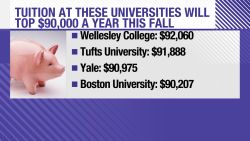Deficits are cool again in Washington. After a few years of stabilizing toward the end of the Obama administration, the annual budget deficit is on track to reach $1 trillion in the near future.
Here are three things you need to know.
A short history of federal deficits
Budget deficits are the norm in Washington. The United States has run a budget deficit for nearly two decades straight. The last time it recorded a budget surplus was between 1998 and 2001. The last time before that: 1969.
But running a deficit isn’t necessarily bad. In the short term, government spending can boost the economy. One big contributor to the latest budget deficit predictions is the 2018 tax cut. That helped give the economy a super charge last year, but it also drastically reduced the amount of revenue the United States collects from taxpayers.
“Spending has continued to rise in line with its long-run trend, but the tax cuts introduced at the start of last year have prevented revenues from rising more substantially,” wrote Paul Ashworth, chief US economist at Capital Economics, in a note.
The White House Office of Management and Budget projects the deficit to top $1 trillion this year, while the Congressional Budget Office expects it to climb to $900 billion by the end of 2019.
The last time the difference between US government spending and its revenue was that massive was in 2012, in the aftermath of the Great Recession.
Interest is the killer
As the deficit grows, the government’s debt will pile up. In the first quarter of 2019, the United States’ debt load was nearly $70 trillion.
To borrow that much debt, the country needs to pay an enormous amount of interest to its bondholders. The United States’ interest burden was more than $800 billion in the first quarter. And the higher the debt grows, the bigger the interest bill will get too.
That’s why, in times of economic prosperity, countries typically pay down their debt. Adding tax cuts with an unemployment rate below 4% represented “a complete breakdown of fiscal discipline,” said Ashworth.
But the good news, is the United States will probably get an assist from the Federal Reserve on its interest payments.
In the beginning of the year, CBO had expected that growing government debt along with rising interest rates would lead to higher interest costs for the United States. But since then, the Federal Reserve pivoted back to a lose monetary policy stance.
The market expectation for a rate cut at next week’s Fed meeting is 100%. And with the Fed lowering interest rates, it will be relatively cheaper for United States to service its debt. At least for now.
Why the market isn’t panicking
Although some investors are keeping a close eye on the country’s fiscal report card, the market appears sanguine on the whole: Stocks are close to record highs.
This is in part because the Federal Reserve is expected to cut interest rates at next week’s monetary policy meeting. The rate cut, just like further government spending, is intended to shore up economic growth.
Plus, this week Congress and the White House agreed to suspend the debt ceiling for the next two years as part of a budget deal. That means the massive budget deficit will be a problem that won’t get resolved anytime soon.
The bill supported markets at the start of the week, but “it also means that the US budget deficit will soar further,” said Marshall Gittler, chief strategist at ACLS Global, in a research note.
As long as the economy continues to expand, the United States will almostcertainlybe able to maintain its debt-fueled spending pattern.
But if the economy turns, trouble could brew. If government’s debt spirals out of control, the bond market would be one of the first places to react and yields on US Treasuries would climb. That would translate into higher interest payments for the United States, making debt payments more expensive.
So far, however, no worries seem to be in sight, and the 10-year US Treasury bond yield is 2.0515%, near its lowest level of the year.
























